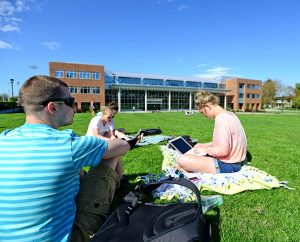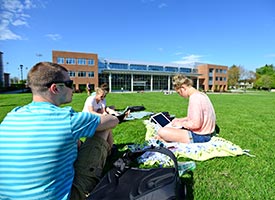By Paula Schlueter Ross
It may be the same old song, but the melody’s pretty sweet: Every year that the Synod’s Concordia University System of 10 colleges and universities nationwide has been in operation — 21 years! — total enrollment has grown.
In other words, every year Concordia University System (CUS) schools together set a brand-new enrollment record.

This 2013-14 academic year is no different. This fall’s total CUS enrollment in both graduate and undergraduate programs grew 12.8 percent — from 29,597 last fall to 33,399 this year, an increase of 3,802 students.
Both the number of graduate and undergraduate students grew — from 13,790 to 16,819 for graduate (an increase of 3,029 students, or 22 percent), and from 15,807 to 16,580 for undergraduate (up 773 students, or 4.9 percent).
“Enrollment across the CUS has risen every year since the CUS was incorporated in 1992,” acknowledged the Rev. Dr. Alan W. Borcherding, CUS director of University Education. “Credit goes to the hard work and ability of our administrative staff members at the institutions, and it is especially noteworthy in this difficult higher-education environment.”
The number of students who identify themselves as Lutheran fell slightly, with 4,030 indicating they are “LCMS” (down 159) and 2,119 checking the “other Lutheran” box (down 8). Those designating “other faiths” also fell, from 899 to 845 (down 54).
A total of 1,255 declared themselves “unchurched” (up 196), and 10,759 students did not declare a religion (up from 7,945 in 2012). Also up are the number of “other Protestant” (by 801, to 9,722) and Roman Catholic (by 212, to 4,669) students.
Fewer church-work students
Although total CUS enrollments continue to climb, the number of students in church-work programs continues to fall — from a total of 1,654 in 2012 to 1,531 this year, a drop of 123 students, or 7.4 percent. Except for an increase of 54 students in fall 2010, that total has been dropping for at least the past 13 years, according to CUS staff.
Sadly, the number of students enrolled in virtually every church-vocation program fell except director of family life ministry, which gained 1, for a total of 28.
Drops were recorded in enrollments for those seeking a Lutheran teacher diploma (down 45, to 1,011) as well as in pre-seminary (down 22, to 156), lay ministry (down 18, to 32), director of Christian education (down 17, to 251), deaconess (down 11, to 21), director of Christian outreach (down 6, to 9) and director of parish music (down 5, to 23).
CU-Portland: ‘walking the talk’
Getting a gold star among the seven CUS schools that reported gains in enrollment is Concordia University Portland in Portland, Ore. Even though it’s located in the Northwest, a part of the country not known for having a large number of believers, the Lutheran school’s enrollment grew by an astounding 74 percent — from 3,111 in 2012 to 5,428 this fall, an increase of 2,317 students.
Longtime CU-Portland President Dr. Charles Schlimpert, now in his 31st year, calls this year’s enrollment figure “terrific, but not unexpected” because “as a part of our strategic planning process, we’ve been very deliberate about going into the online arena.” The vast majority of new students — as many as 80 percent — are enrolled in the school’s online graduate programs in education (M.Ed. and Ed.D) and, since last month, business (MBA). Next year, CU-Portland plans to begin offering online a master’s in health care administration (MHA).
With limited on-ground space (CU-Portland opened a law school last year in Boise, Idaho) and a commitment to reach as many students as possible, the school sees online education as being an integral part of its mission.
“We’re still about the business of preparing leaders who will make a difference in both their church and their communities,” says Schlimpert. “And we’re taking [the online programs] as an opportunity to reach even more students.”
CU-Portland also is becoming known locally for its humanitarian efforts — a big draw even among those with no particular religious convictions, according to Schlimpert. A 10-year partnership with a neighboring public school — some 200 Concordia students and faculty volunteer their time at Faubion Elementary School every week, he says — has morphed into an opportunity to build a public-private partnership. Dubbed “3 to Ph.D.,” the project will address the full education continuum and provide “wrap-around” services for families including an early childhood center, resource center and health-and-wellness clinic.
“People are saying ‘Concordia’s not trying to intimidate me with their religion. What they are [doing] is, they’re walking the talk,’ ” says Schlimpert. “And then you have your moment of opportunity: They say, ‘Why do you do this?’ And then you can share your faith. That’s what’s really powerful about this.”
CU-Portland Provost Dr. Mark Wahlers underscores the quality of the school’s online courses: Class size is kept to a maximum of 15 students who stay together as a cohort until graduation. (More than 85 percent of its online students complete their degrees, by the way.) And faculty members — all Christian — are required to integrate faith and learning in courses that are just as rigorous as their on-campus counterparts.
Concordia’s education-with-service model “resonates with people, whether they’re Lutheran or not, Christian or not,” says Wahlers. “People want to make a difference in the world.”
Sharing “a Concordia experience with as many people as we can” — both on-ground and online — also is a way that “we can fulfill the Great Commission,” he adds. “We feel very strongly about that.”
Individual enrollments
This fall’s enrollments — including both graduate and undergraduate students — at individual CUS schools are as follows:
- Concordia University, Ann Arbor, Mich. — 740 (an increase of 72 students, or 10.8 percent, over fall 2012).
- Concordia University Texas, Austin — 2,565 (down 19, or .7 percent).
- Concordia College—New York, Bronxville — 953 (up 86, or 10 percent).
- Concordia University, Irvine, Calif. — 4,046 (up 527, or 15 percent).
- Concordia University Wisconsin, Mequon — 7,943 (up 192, or 2.5 percent).
- Concordia University, Portland, Ore. — 5,428 (up 2,317, or 74 percent).
- Concordia University Chicago, River Forest, Ill. — 5,286 (down 168, or 3 percent).
- Concordia College Alabama, Selma — 600 (down 11, or 1.8 percent).
- Concordia University, St. Paul, Minn. — 3,632 (up 691, or 23 percent).
- Concordia University, Nebraska, Seward — 2,206 (up 115, or 5.5 percent).
For more information about LCMS colleges and universities — and professional church-work careers — visit the website of LCMS University Education at lcms.org/cus.
Seminary enrollment
First, the good news: Total enrollment in all programs at Concordia Seminary, St. Louis, and Concordia Theological Seminary, Fort Wayne, Ind., combined is up this fall — from 897 last year to 934 this year, an increase of 37 students, or 4 percent.
Also up, “very dramatically,” according to the Rev. Dr. Glen Thomas, executive director of Pastoral Education for the LCMS, is the number of new graduate-degree-program students enrolled at the Synod’s two seminaries: a total of 69 — 26 more than last year.
“Every graduate-degree program is at or above the number of new students who enrolled last year, resulting in an increase of 56 in the total number of graduate-degree students over last year,” Thomas said.
“Many of our graduate-degree-program students will be the theological leaders of the future in our Synod and in other church bodies around the world,” he noted. “In this way, our seminaries provide theological leadership that is global in scope.”
Thomas said he is “particularly encouraged” to see nine new pastoral-ministry students in the Center for Hispanic Studies and seven new pastoral-ministry students in the Ethnic Immigrant Institute of Theology: “These future pastors will be particularly helpful in light of the changing demographic nature of our nation.”
And, although total ordination-track enrollment at the two LCMS seminaries fell — from 699 last fall to 683 this year, with 16 fewer students — “The first word that needs to be spoken is a word of thanks to the Lord of the harvest for raising up the 683 students at our seminaries who are preparing to serve in pastoral ministry with the LCMS,” says Thomas. “These men are the answers to the prayers of God’s people for workers in His harvest field.”
Still a “challenge,” he said, is the decreasing number of new residential ordination-track students. This year’s 114 new residential students matches the number recorded two years ago, in 2011, but falls short of the 140 new residential students for 2012.
“Pastoral formation begins at the baptismal font,” Thomas said. “We continue to call upon God’s people to identify, inform and encourage appropriate candidates for pastoral ministry.”
Enrollment statistics for the seminaries individually are as follows:
- Concordia Seminary, St. Louis, reported a total enrollment of 633 students (30 more than last year), with 485 enrolled in programs leading to ordination, the same as in 2012.
Its ordination-track student body includes 267 M.Div. students, 16 residential alternate-route students and 202 nonresidential students.
Other advanced-degree programs have 132 students enrolled, including 10 M.A. deaconess students (11 additional deaconess students are non-M.A.), 71 Ph.D. students and 7 D.Min. students.
- Concordia Theological Seminary, Fort Wayne, Ind., reported a total enrollment of 301 (7 more than last year), with 198 enrolled in programs leading to ordination (down 16).
Its ordination-track student body includes 162 M.Div. students, 12 residential alternate-route students and 24 nonresidential students.
Other advanced-degree programs have 94 students enrolled, including 30 M.A. deaconess students, 27 Ph.D. students and 22 D.Min. students.
For more information about the Synod’s seminaries, visit the LCMS Pastoral Education website at lcms.org/pastoraleducation.
